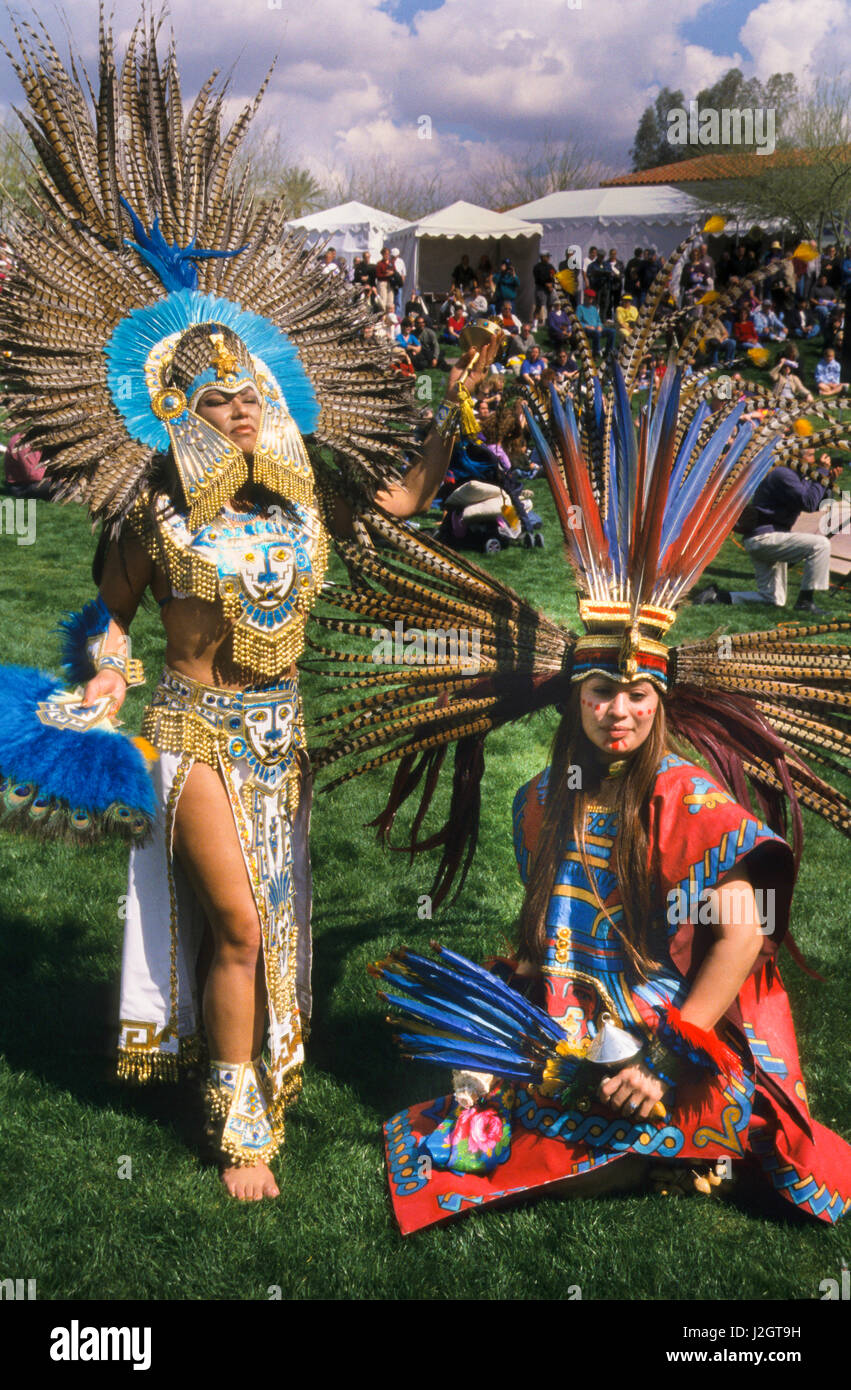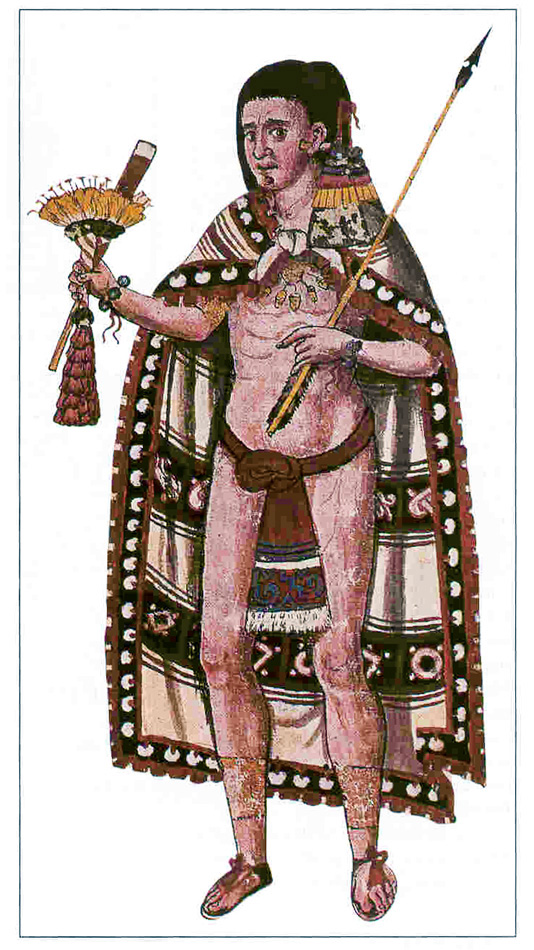
Aztec ceremonial dress hires stock photography and images Alamy
A ruler, on the other hand, would sport the finest embroidered and decorated example of 'the most important status item of male wearing apparel', the tilmatli, a cotton cloak, cape or mantle. In the picture (right) sits the emperor Moctezuma, wearing a nose jewel and the royal diadem on his head. Note that, appropriate to his status, his.

Pin by Jennifer Preston on Aztecs Aztec clothing, Aztec culture, Aztec empire
First is the draped garment, formed simply by wrapping a piece of material around the body. Examples of this among Aztec/Mexica costumes would be the male maxtlatl (loin-cloth: see Fig 1), the male tilmatli (cape), and the female cueitl (skirt). Fig 4: A newly-married woman spins cotton thread, Codex Mendoza, folio 68r.

Copillis Trajes de danza azteca, Traje azteca, Vestimenta azteca
Aztec clothing was an essential aspect of Aztec culture, reflecting social status, occupation, and religious beliefs. Common materials used in Aztec clothing included cotton, maguey fibers, and animal skins. Clothing was often adorned with intricate patterns, embroidery, and featherwork, showcasing the skill and artistry of Aztec weavers.

no feathers American Indians, Native American, Aztec Costume, Aztec Clothing, Estilo Tribal
First, Aztec society was divided between distinct classes, and the different classes wore different types of clothing. For example, the high priests, nobility and royalty would wear very ornate clothing while the lower classes would not. Second, the basic item in Aztec clothing for men was the 'maxtlatl', which was a type of loincloth.

Aztec Royalty
Aztec clothing was worn by the Aztec people and varied according to aspects such as social standing and gender. The garments worn by Aztecs were also worn by other pre-Columbian peoples of central Mexico who shared similar cultural characteristics. The strict sumptuary laws in Aztec society dictated the type of fiber, ornamentation, and manner.

Aztec fashion, Aztec clothing, Clothes for women
Aztec clothing illustrated, v2. We're sincerely grateful to Daniel Parada for producing specially for us this beautiful new illustrated guide to Aztec clothing styles (updated, March 2020!), showing in simple terms the range of styles for both adults and children. A free copy of this resource will be given to each school that our teaching.

female aztec maya inca clothing fashion design Google Search Mayan culture, Aztec costume
The Aztec clothing can be defined as the various forms of attire that were worn by the Aztecs and other Mesoamerican peoples that lived in the Aztec Empire. It should be noted that the clothing styles preferred by the Aztecs were also similar to the clothing that was worn by many other groups in Mexico and much of Mesoamerica. Like any culture.

Aztecas vestimenta en 2019 Cultura azteca, Culturas prehispanicas y Arte azteca
Aztec artifacts include all the historical elements that were left behind by the Aztec people and have been discovered by historians, adventurers and archaeologists. They can include the vast cities and pyramids built by the Aztec people or the intricate, jewellery, clothing and weapons covered in gold and precious stones.

Danza Azteca Guadalupana Mexican cultural traditions from Florida Aztec dancers Native
The Aztec faith shared many aspects with other Mesoamerican religions, like that of the Maya, notably including the rite of human sacrifice. In the great cities of the Aztec empire, magnificent.

Aztec Dancer Aztec warrior, Aztec costume, Aztec culture
History of the Aztecs. The Aztec fashion hails down from the Aztec Empire, which was one of the largest empires to ever exist in America. It stuck around for almost five centuries, from 1300 to 1521 AD; thus, its expansive influence seems understandable. The empire was huge and covered an area of about half a million square miles in the Central.

Aztec Parade Dancer, Mexico Aztec culture, Aztec warrior, Aztec headdress
The Aztec clothing trends varied through the history of the Aztecs, although some elements remained more or less the same. The Aztec Empire was established in 1428 as a result of the civil war and the new empire had a military outlook.

ArtStation Aztec clothing studies, Daniel Parada Vestimenta azteca, Culturas prehispanicas
Though the Mayans, Aztecs, and Incas were separated in time and in geography, their clothing closely resembled each other. In general, children were naked, and men wore loincloths, adding tunics, or shirts, and cloaks in colder weather. The dress of women was more variable. Mayan women wore skirts with or without a scarf tied to cover their.

Postclassic Aztec Female Commoner by Kamazotz on DeviantArt Aztec clothing, Aztec culture
While simple clothing was the choice for daily living, festival or ceremonial clothing could be elaborate, decorated with fur and feathers and trim of contrasting colors and fabrics. Aztecs decorated themselves with jewelry—nose rings, ear rings and plugs, labrets for the lips and tongue, necklaces, bracelets and rings were made of precious metals or carved from bone, shells, antler or wood.

Clothing Ranks Aztec clothing, Aztec civilization, Tenochtitlán
PIC 3: 'On the left, a woman in the typical Aztec huipil over a cueitl. To the right, the woman is dressed as in the early post-Conquest period, retaining the Aztec cueitl and adding a European-style blouse.'. Picture sources:-. • Pix 1 & 3, as noted above, by Alberto Beltrán. • Pic 2: photo by Sean Sprague/Mexicolore.

Aztec Mexico Native american women, Native american beauty, Aztec culture
Aztec clothes were fairly simple, but they certainly did the job when it came to keeping the men and women of this empire warm in the varied Mexican climate. While there was a great deal of variation in clothing throughout the Aztec empire, these were the basic garments that were worn.

Pin de Caarrerin en mlk (con imágenes) Cultura azteca, Vestimenta azteca, Indigenas en mexico
Aztec, Nahuatl-speaking people who in the 15th and early 16th centuries ruled a large empire in what is now central and southern Mexico. The ninth emperor, Montezuma II, was taken prisoner by Hernan Cortes and died in custody. His successors were unable to stave off Cortes, and the empire came to an end in 1521.